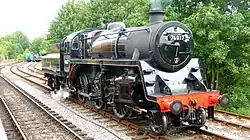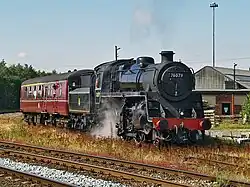BR Standard Class 4 2-6-0
| BR Standard Class 4 2-6-0 | |||||||||||||||||||||||||||||||||||||||||||||||||||||||||||
|---|---|---|---|---|---|---|---|---|---|---|---|---|---|---|---|---|---|---|---|---|---|---|---|---|---|---|---|---|---|---|---|---|---|---|---|---|---|---|---|---|---|---|---|---|---|---|---|---|---|---|---|---|---|---|---|---|---|---|---|
 British Railways No. 76000 in 1952. | |||||||||||||||||||||||||||||||||||||||||||||||||||||||||||
| |||||||||||||||||||||||||||||||||||||||||||||||||||||||||||
| |||||||||||||||||||||||||||||||||||||||||||||||||||||||||||
| |||||||||||||||||||||||||||||||||||||||||||||||||||||||||||
| |||||||||||||||||||||||||||||||||||||||||||||||||||||||||||
The BR Standard Class 4 2-6-0 is a class of steam locomotive designed by Robert Riddles for British Railways (BR). 115 locomotives were built to this standard.
Design and construction
The class was designed at the ex-LNER works at Doncaster which was also responsible for building 70 of the 115-strong class. The remaining 45 were built at Horwich.[1] None were built at Derby Works although it was intended that 20 would be built there, Doncaster in fact took them on.
The last in the series, No.76114, was also the final steam engine to be constructed at the 'Plant' (as Doncaster works was known). 76099 was last steam locomotive to be built at Horwich and in fact, was the last of the class to be completed, just after 76114 at Doncaster. The Standard Four Mogul was essentially a standardised version of the LMS Ivatt Class 4, and was primarily intended for freight use.
Although a BR Standard, the 4 2-6-0 class did not have the same design of wheels as the Swindon-built 82XXX and 77XXX Class 3 engines which also had 5-foot-3-inch (1.600 m) driving wheels, yet all three locomotive classes share the same cylinder casting.
The cylinder covers of engines built early in the programme of construction were fitted with "screw-in" type pressure relief valves. From September 1955 revised cylinder covers were introduced for renewals incorporating "bolt-on" type pressure relief valves.[a] Rectangular type coupling rods rather than the original fluted type, were fitted to 76035 onwards.[1]
Operation
With its 5-foot-3-inch (1.60 m) diameter driving wheels this sixth of the BR standard designs was clearly biased towards freight working. An axle-loading of only 16 long tons 15 cwt (37,500 lb or 17 t) meant its route availability was virtually unrestricted. Batches were allocated to every BR region except the Western.[2]
Accidents and incidents
- On 23 September 1954, locomotive No. 76017 was hauling a freight train that overran signals and was derailed by trap points at Whitchurch Town station, Hampshire.[3]
- In December 1957, locomotive No. 76016 was hauling a freight train that overran signals and was derailed by trap points at Woodhay station, Hampshire.[3]
- On 12 February 1960, locomotive No. 76026 was hauling a freight train that overran signals and was derailed by trap points at Whitchurch Town station.[3]
Preservation
Four engines have survived into preservation, all four built at Horwich Works and rescued from Woodham Brothers scrapyard at Barry Island. Three members of the class have steamed so far in preservation but 76077 has yet to do so and is at present undergoing restoration from scrapyard condition. As of September 2023, no members of the class are mainline certified. All three engines that have run in preservation have been on the main line, but only two have hauled railtours, 76079 and 76084. On 13 October 2022, 76017 was moved by rail from its home at the Watercress Line to the Bluebell Railway.[4]
76079's main career on the main line was when it was owned by Ian Riley in Bury, Lancashire, but it was eventually sold to the NYMR. After completion of its most recent overhaul in 2014 it once again had a mainline certificate but was restricted between Battersby and Whitby on the Esk Valley Line. 76084 meanwhile, was certified to operate over the national network hauling railtours alongside passenger runs along the Bittern Line and the Esk Valley Line.
| BR No. | TOPS No. (if applicable) | Built | Withdrawn | Service life | Home base | Owner | Livery | Tender Attached | Status | Mainline Certified | Image | Notes |
|---|---|---|---|---|---|---|---|---|---|---|---|---|
| 76017 | 98417 | May 1953 | Jul 1965 | 12 Years, 1 month | Kent & East Sussex Railway [5] | John Bunch | BR Lined Black, Early Emblem | BR2A | Operational. Boiler Ticket Expires: 2026. | No, to be certified | 
|
Recently changed ownership following death of previous owner.[6] |
| 76077 | - | Dec 1956 | Dec 1967 | 11 Years | Gloucestershire Warwickshire Railway | Toddington Standard Locomotive Limited | N/A | Under Restoration from scrapyard condition | No | 
|
Fundraising for the boiler overhaul is underway and the tender pattern is confirmed as being a BR2A pattern.
Restoration anticipated for completion in 2026.[7] | |
| 76079 | 98476 | Feb 1957 | Dec 1967 | 10 Years, 10 months | North Yorkshire Moors Railway | North Yorkshire Moors Railway | BR Lined Black, Early Emblem | Stored | No | 
|
Withdrawn for overhaul due to issues with boiler.[8]
Currently stored in Pickering carriage shed. | |
| 76084 | 98484 | Apr 1957 | Dec 1967 | 10 Years, 8 months | North Norfolk Railway | 76084 Locomotive Company Limited | BR Lined Black, Early Emblem | Stored. Boiler Ticket Expired: Dec 2023. | No (2016 - 2023) | .jpg)
|
Withdrawn for 10 year overhaul. [9] |
Models
The erstwhile Kitmaster company produced an unpowered polystyrene injection moulded model kit for 00 gauge. In late 1962, the Kitmaster brand was sold by its parent company (Rosebud Dolls) to Airfix, who transferred the moulding tools to their own factory; they re-introduced some of the former Kitmaster range, including this locomotive. In time, the moulding tools passed on to Dapol who have also produced the model kit.[10]
Bachmann produces a ready-to-run model in both OO[11][12] and as part of their Graham Farish range for British N gauge.[13]
Sound
- 76079 Between Egton and Grosmont
- 76079 departing from Grosmont
Notes
- ^ Rear cylinder cover SL/SW/35 being superseded by SL/SW/666 and front cylinder cover SL/SW/85 being superseded by SL/SW/667 for renewals from September 1955
References
Citations
- ^ a b British Railways Standard Steam Locomotives. Vol. 2: the 4-6-0 and 2-6-0 classes. RCTS. 2003. ISBN 090-1115-93-2.
- ^ Duggan, Jamie (29 June 2018). "BR Standard 4s (4-6-0, 2-6-0 and 2-6-4T) steam locomotives - Class Information". RailAdvent. Retrieved 12 September 2022.
- ^ a b c Bishop, Bill (1984). Off the Rails. Southampton: Kingfisher. pp. 55–65. ISBN 0-946184-06-2.
- ^ "Light Engine Movement (Alton MHR - East Grinstead)". RailAdvent. 10 October 2022. Retrieved 26 October 2023.
- ^ "Steam locomotive 76017 to be based in Kent for 2024". RailAdvent. 3 April 2024.
- ^ "Mogul goes Mainline to Southall". Heritage Railway Magazine. No. 301. December 2022. p. 16.
- ^ "loco information on 76077's restoration". The Roster. Steam Railway. No. 550. October 2023. p. 38.
- ^ "76079 withdrawn owing to issues with flue ends requiring new tubeplate". Steam Railway. No. 548. August 2023. p. 39.
- ^ "Engineering News". 76084 Locomotive Company Limited. 7 August 2023. Retrieved 8 December 2024.
- ^ Knight, Stephen (1999). Let's Stick Together: An Appreciation of Kitmaster and Airfix Railway Kits. Clopthill: Irwell Press. ISBN 1-871608-90-2.
- ^ Jones, Ben (December 2007). "Bachmann BR 4MT 2-6-0". Model Rail. No. 111. Peterborough: EMAP Active. pp. 32–35. ISSN 1369-5118. OCLC 173324502.
- ^ Wild, Mike (December 2007). "Bachmann 'Standard Four' shows its pedigree". Hornby Magazine. No. 6. Hersham: Ian Allan Publishing. pp. 88–89. ISSN 1753-2469. OCLC 226087101.
- ^ "Catalogue No 32-952A". Archived from the original on 4 March 2016. Retrieved 25 June 2020.
Bibliography
- A Detailed History of BR Standard Steam Locomotives, - Vol 2 - The 4-6-0 and 2-6-0 Classes. RCTS ISBN 0-901115-93-2
- Bradley, Rodger P. (1984). The Standard Steam Locomotives of British Railways. David & Charles. ISBN 0715383841.
Further reading
- Wild, Mike (December 2007). "The BR 'Standard Four' 2-6-0s". Hornby Magazine. No. 6. Hersham: Ian Allan Publishing. pp. 70–73. ISSN 1753-2469. OCLC 226087101.